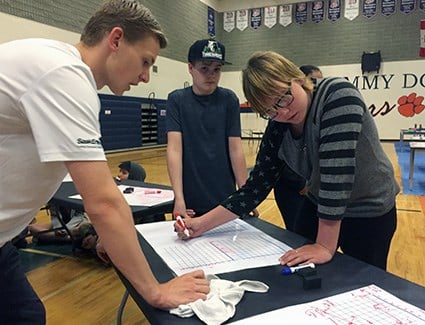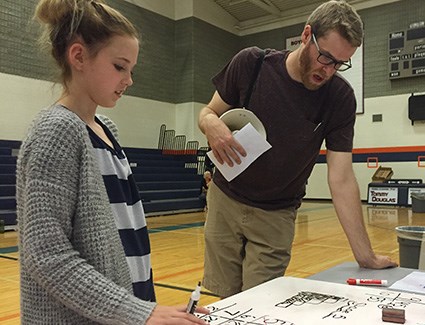 The first mathematical test for students organizing the Tommy Douglas Collegiate Math Fair was determining whether the school had enough tables to set up the stations for the hundreds of elementary students attending the third annual event.
The first mathematical test for students organizing the Tommy Douglas Collegiate Math Fair was determining whether the school had enough tables to set up the stations for the hundreds of elementary students attending the third annual event.
Organized by teacher Nat Banting and students in his Grade 9 enriched mathematics class, the math fair involves students in every step of planning and logistics, from determining the scale of the gym, creating the problems for each of the stations and even budgeting for the 50 dozen doughnuts served to participants.
Banting says bringing together elementary and high school students to explore math and share in a learning experience has been a positive experience for all involved. Planning the event is an eagerly anticipated major project for his class each year.
"It's a cool, connective thing," he said. "This is a community building event; it is a staple of things around here. The amount of work we go through to prepare this thing is super rewarding.
"At the very beginning of Math 9 students ask 'What about this math fair?' About 60 per cent of the students who are now my Grade 9 students were at a math fair so we are building that human capital. A lot of the Grade 10s and 11s who are now leaders and volunteers have been asking 'When is math fair, I want to help.' "
The first math fair held in 2015 was a spur-of-the-moment event organized in less than two weeks after a student suggested it would be good to share their learning with others. That event attracted 70 students from two schools. Attendance jumped to 330 students from five schools in 2016 and this year's event held June 12 saw almost 470 students from seven schools joining 50 volunteer student leaders.
Niya Saycocie attended the math fair in 2016 as a Grade 8 student. This year, she was leading a group of students through the stations and encouraging them to explore and be creative with math.
"I was really surprised how big everything could get. Last year it was half of the gym and this year it grew. We have five groups (stations) and each of them focus on a main perspective of our mathematics. In Grade 9 math you have think outside of the box," said Saycocie, who hopes the experience provided the visiting students with a new perspective on math.
"They are learning the broad spectrum of mathematics," adds classmate Jordan Friesen. "All of these stations have easier levels and you make it incredibly complicated to try and stretch their mind. Nothing is as simple as it may seem."
 The way in which Tommy Douglas students share their learning and assume a leadership role in working with the younger students is an empowering experience, according to Banting.
The way in which Tommy Douglas students share their learning and assume a leadership role in working with the younger students is an empowering experience, according to Banting.
"They have been a student now for a while and generally the pattern goes that the teacher invents and/or bequeaths a problem to the students, the students then work on it and respond," he said.
"But when you ask them: What if one of your students does this, their mindset switches from problem-solver to problem generator. What is the best way that they can prompt that student to have a rich mathematical experience? In that sense they are really interrogating how they learn, they are entertaining suggestions and opportunities on how other people learn. Right away they become very interested in that."
The themes and activities at each of the stations are developed and guided by the students and a lot of consideration and refinement takes place in the weeks leading up to the math fair in order to provide an engaging learning experience.
"They interrogate the mathematics at each of the five stations so much and each one of those is purposefully selected to match up with one of the strands of the elementary curriculum," Banting said of his students' preparation. "They are back in their own shoes, thinking about how they understood when they were in Grade 7."
While the focus of the event is math, it also provides a glimpse of the high school experience for the Grade 7 and 8 students in attendance and plays a role in promoting a smooth transition for students moving from elementary school to high school.
"It gets people comfortable with the high school students," said Friesen. "It bring them the realization that we are not as scary. For sure I thought that high schoolers were a whole step above, but it's not that different."
Banting says the event has built connections between students, noting that some of the Grade 9 student leaders asked to be paired with specific senior students who had been their leader at previous math fairs.
"The mathematics has been really profitable . . . but to tie this explicitly to their future experience at Tommy Douglas has been really beneficial," he said. "The teachers have mentioned that transitional benefit — alongside that kids may not have seen or had the licence to think about mathematics like this before. When you chuck it into a gym with 300 other people the energy is infectious."
The math fair stations present challenges that are designed to push, prod and perturb participants to think differently and as a result the students end up experiencing mathematics as a "wide-open, wonderful thing," according to Banting.
"When you have those 300 people and an idea comes forth at a station you can feel it," he said. "A lot of times I am hovering around and you can see that group had an idea, you can see them buzzing. You can see the idea kind of percolate through because it is so open. Someone peeks over and says 'That's an interesting starting point.' They are not copying each other, they are using each other as launching points for their own inquiries."